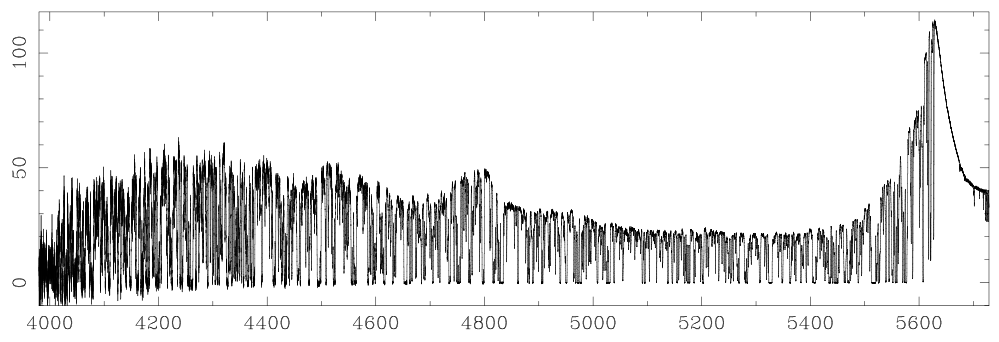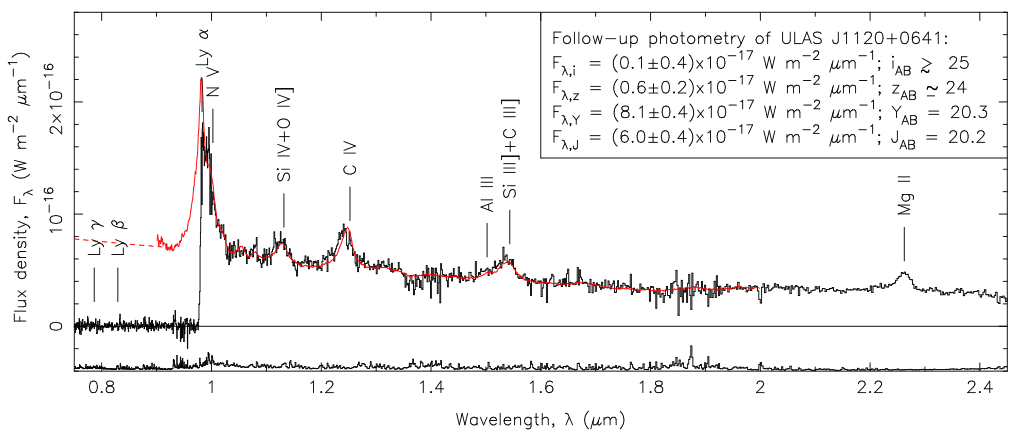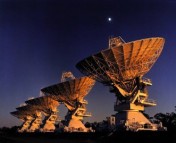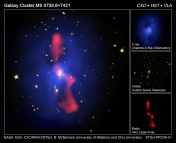Paper: A Luminous Quasar at a Redshift of z=7.085
Authors: Daniel J. Mortlock, Stephen J. Warren, Bram P. Venemans, Mitesh Patel, Paul C. Hewett, Richard G. McMahon, Chris Simpson, Tom Theuns, Eduardo A. Gonzales-Solares, Andy Adamson, Simon Dye, Nigel C. Hambly, Paul Hirst, Mike J. Irwin, Ernst Kuiper, Andy Lawrence, Huub J. A. Rottgering
First Author’s Institution: Astrophysics Group, Imperial College London, Blackett Laboratory, London
While high-redshift quasars are very interesting objects in their own right, their incredible luminosities allow them to act as background light sources that illuminate the intervening universe on our line of sight. One could think of quasars as giant flashlights that the universe uses to make really interesting spectroscopic shadow puppets back here on Earth.
In their Nature Letter, Mortlock et al. report on the discovery of a new quasar at a redshift of z = 7.085. In LCDM cosmologies, this corresponds to just 0.77 billion years after the Big Bang.
Only three objects have been spectroscopically confirmed to be at higher redshift, two faint galaxies and a gamma-ray burst which has since faded. Thus, this bright quasar (ULAS J1120+0641) currently provides the best probe of the high redshift universe. It is extremely bright for such a distant object, with a J-band magnitude of 20.2. By comparison, the aforementioned higher redshift galaxies have J > 26, which means they are over a factor of 100 fainter as observed from Earth.
Mortlock et al. use the high redshift and luminosity of the quasar to study two important aspects of the early universe: the neutral fraction of hydrogen before the universe was completely re-ionized and supermassive black hole growth at the dawn of the universe.
Because quasars like ULAS J1120+0641 are bright and at high redshift, lower redshift intervening material can absorb some of their light, leaving fingerprints on the final spectrum that we observe on Earth. Because hydrogen is the most abundant element in the universe, it should come as no surprise that it leaves the most prominent spectral signature, in the form of a forest of absorption lines.

Figure 1: The Lyman Alpha absorption line forest. The broad emission feature at the right of the plot is the Lyman alpha intrinsic to the quasar, while the dense series of absorption lines to the left are from the intervening neutral hydrogen at lower redshifts. Figure from Rauch 1998: http://arxiv.org/abs/astro-ph/9806286
The Lyman alpha transition is seen in absorption when neutral hydrogen in the ground state absorbs an incoming photon and moves to the first excited state. Since neutral hydrogen has a “bound” electron to it’s proton, it can absorb and emit radiation through bound-bound radiative transitions between energy levels. When hydrogen is ionized, it can no longer absorb radiation through bound-bound or bound-free transitions (since it is already “free” of it’s electron).
The broad emission line at the right of Figure 1 is the Lyman alpha emission intrinsic to the quasar. By using this line to get the redshift of the quasar, we set our upper bounds on the wavelength Lyman alpha absorption. Therefore, any Lyman alpha absorption features which we see at lower redshift (shorter wavelengths) must be due to intervening material. Every time a cloud with neutral hydrogen intersects our line of sight, we get an absorption spike. The collection of these spikes spread out over redshift is what we call the “Lyman alpha forest,” since there is a forest of lines!
Let us see the forest for the trees and examine what these spectroscopic patterns mean for the history of the early universe. Following the expansion of the universe and cooling after the big bang, protons and electrons eventually combined to form neutral hydrogen, and in the process released the radiation of the cosmic microwave background. This was first the time in history which we had neutral atoms (hydrogen, helium, and not much else). Eventually, as the first stars and galaxies formed from this primordial gas, enough ionizing radiation was produced to separate the electrons from the protons, “re-ionizing” the material in our universe. The Lyman alpha forest can be used to trace this re-ionization of the universe.

Figure 2: The spectrum of quasar ULAS J1120+0641, overlaid with a template quasar spectrum in red. Many of the quasar emission lines are identified, including Mg II, which is used to estimate the mass of the supermassive black hole believed to be at the center of the quasar. Also, note the strong absorption to the right (shorter wavelength and lower redshift) of the Lyman alpha line intrinsic to the quasar. From Mortlock et al. 2011: http://arxiv.org/abs/1106.6088
Quasars are likely powered by accretion onto supermassive black holes at the center of their galaxies. Using the width of the Mg II spectral line, it is possible to estimate the mass of the black hole using mass-scaling relationships. A variety of other diagnostics for black hole masses are summarized in two papers on the arXiv by Vestergaard. Mortlock et al find that the quasar hosts a black hole with a mass greater than , which is among the most massive known black holes. Essentially, the finding that there are supermassive black holes so early on in the history of the universe provides even more severe constraints on the pace of black hole formation.
In conclusion, the authors focus on the need for the discovery of more bright quasars at high redshift, because, although they are rare, these objects provide some of the best probes of the early universe.





Thank you for posting this informative paper. You mentioned J-band magnitude of 20.2. I am looking for the other filter values for shorter wavelengths (blue side) but have had no success. Can you please advise?